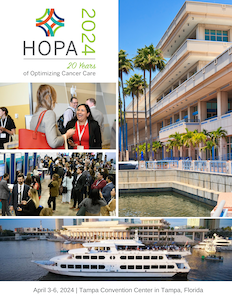Back
Trainee Research
Category: Blood & Marrow Transplantation / Cellular Therapy
(044) Comparison of Fludarabine Versus Clofarabine in Combination with Cyclophosphamide and Total Body Irradiation Conditioning Regimens for Allogeneic Bone Marrow Transplantation
Friday, April 5, 2024
12:00 PM – 2:00 PM ET

Caroline A. Jones, PharmD
PGY2 Oncology Pharmacy Resident
AdventHealth Orlando
Orlando, Florida, United States
Presenting Author(s)
Poster Abstract:
Background:
Allogeneic hematopoietic stem cell transplantation (HSCT) is a potential curative treatment for patients with multiple hematologic malignancies and non-hematologic diseases. The Center for International Blood and Marrow Transplant Research (CIMBTR) has reported that roughly 12,000 first autologous HSCT and over 8,000 first allogeneic HSCT occurred in the US during 20211. Conditioning regimens are used for antileukemic effect, graft-versus-leukemia effect, and immunosuppressive effects2. Fludarabine, in combination with cyclophosphamide, and total body irradiation (FluCyTBI) is an effective reduced intensity regimen utilized in haploidentical transplants3. In 2020, there was significant shortage of fludarabine. The National Comprehensive Cancer Network (NCCN) and American Society for Transplantation and Cellular Therapy (ASTCT) recommended alternative regimens based on institutional preference and experience due to lack of comparative data4,5. Our institution shifted to the use of clofarabine as an alternative during the fludarabine shortage. Therefore, the aim of this study was to compare the efficacy and safety between fludarabine and clofarabine based conditioning regimens used at our institution for allogeneic bone marrow transplantation.
Objectives/
Methods:
This was a single-center, retrospective cohort study. Patients were at least 18 years old, received fludarabine or clofarabine based conditioning regimens between January 2021 and January 2023, and adequate organ function. The primary outcome was 12-month progression free survival (PFS), defined as time from stem cell transplantation (SCT) until the date of relapse or death from any cause. Secondary outcomes included time to neutrophil and platelet engraftment, overall survival (OS), incidence of acute and chronic graft-versus-host disease, and organ toxicity (including veno-occlusive disease, infections, and acute kidney injury).
Results:
Will be presented at 2024 HOPA conference
Conclusion:
Will be presented at 2024 HOPA conference
References (must also be included in final poster): 1. Bolon YT, Atshan R, Allbee-Johnson M, Estrada- Merly N, Lee SJ. Current use and outcome of hematopoietic stem cell transplantation: CIBMTR summary slides, 2022.
2. Nagler A, Shimoni A. Conditioning. In: Carreras E, Dufour C, Mohty M, et al., editors. The EBMT Handbook: Hematopoietic Stem Cell Transplantation and Cellular Therapies [Internet]. 7th edition. Cham (CH): Springer; 2019. Chapter 13. Available from: https://www.ncbi.nlm.nih.gov/books/NBK553926/ doi: 10.1007/978-3-030-02278-5_13
3. Fuchs, E. J., O'Donnell, P. V., Eapen, M., Logan, B., Antin, J. H., Dawson, P., Devine, S., Horowitz, M. M., Horwitz, M. E., Karanes, C., Leifer, E., Magenau, J. M., McGuirk, J. P., Morris, L. E., Rezvani, A. R., Jones, R. J., & Brunstein, C. G. (2021). Double unrelated umbilical cord blood vs HLA-haploidentical bone marrow transplantation: the BMT CTN 1101 trial. Blood, 137(3), 420–428. https://doi.org/10.1182/blood.2020007535
4. National Comprehensive Cancer Network (NCCN). NCCN Clinical Practice Guidelines in Oncology. Hematopoietic Cell Transplantation. Version 3.2023. ;National Comprehensive Cancer Network.
5. Majhail NS, Farnia SH, Carpenter PA, et al. Indications for autologous and allogeneic hematopoietic cell transplantation: guidelines from the American Society for Blood and Marrow Transplantation. Biol Blood Marrow Transplant 2015;21:1863-1869
Background:
Allogeneic hematopoietic stem cell transplantation (HSCT) is a potential curative treatment for patients with multiple hematologic malignancies and non-hematologic diseases. The Center for International Blood and Marrow Transplant Research (CIMBTR) has reported that roughly 12,000 first autologous HSCT and over 8,000 first allogeneic HSCT occurred in the US during 20211. Conditioning regimens are used for antileukemic effect, graft-versus-leukemia effect, and immunosuppressive effects2. Fludarabine, in combination with cyclophosphamide, and total body irradiation (FluCyTBI) is an effective reduced intensity regimen utilized in haploidentical transplants3. In 2020, there was significant shortage of fludarabine. The National Comprehensive Cancer Network (NCCN) and American Society for Transplantation and Cellular Therapy (ASTCT) recommended alternative regimens based on institutional preference and experience due to lack of comparative data4,5. Our institution shifted to the use of clofarabine as an alternative during the fludarabine shortage. Therefore, the aim of this study was to compare the efficacy and safety between fludarabine and clofarabine based conditioning regimens used at our institution for allogeneic bone marrow transplantation.
Objectives/
Methods:
This was a single-center, retrospective cohort study. Patients were at least 18 years old, received fludarabine or clofarabine based conditioning regimens between January 2021 and January 2023, and adequate organ function. The primary outcome was 12-month progression free survival (PFS), defined as time from stem cell transplantation (SCT) until the date of relapse or death from any cause. Secondary outcomes included time to neutrophil and platelet engraftment, overall survival (OS), incidence of acute and chronic graft-versus-host disease, and organ toxicity (including veno-occlusive disease, infections, and acute kidney injury).
Results:
Will be presented at 2024 HOPA conference
Conclusion:
Will be presented at 2024 HOPA conference
References (must also be included in final poster): 1. Bolon YT, Atshan R, Allbee-Johnson M, Estrada- Merly N, Lee SJ. Current use and outcome of hematopoietic stem cell transplantation: CIBMTR summary slides, 2022.
2. Nagler A, Shimoni A. Conditioning. In: Carreras E, Dufour C, Mohty M, et al., editors. The EBMT Handbook: Hematopoietic Stem Cell Transplantation and Cellular Therapies [Internet]. 7th edition. Cham (CH): Springer; 2019. Chapter 13. Available from: https://www.ncbi.nlm.nih.gov/books/NBK553926/ doi: 10.1007/978-3-030-02278-5_13
3. Fuchs, E. J., O'Donnell, P. V., Eapen, M., Logan, B., Antin, J. H., Dawson, P., Devine, S., Horowitz, M. M., Horwitz, M. E., Karanes, C., Leifer, E., Magenau, J. M., McGuirk, J. P., Morris, L. E., Rezvani, A. R., Jones, R. J., & Brunstein, C. G. (2021). Double unrelated umbilical cord blood vs HLA-haploidentical bone marrow transplantation: the BMT CTN 1101 trial. Blood, 137(3), 420–428. https://doi.org/10.1182/blood.2020007535
4. National Comprehensive Cancer Network (NCCN). NCCN Clinical Practice Guidelines in Oncology. Hematopoietic Cell Transplantation. Version 3.2023. ;National Comprehensive Cancer Network.
5. Majhail NS, Farnia SH, Carpenter PA, et al. Indications for autologous and allogeneic hematopoietic cell transplantation: guidelines from the American Society for Blood and Marrow Transplantation. Biol Blood Marrow Transplant 2015;21:1863-1869

